M13 was discovered by Edmond Halley in 1714, and catalogued by Charles Messier on June 1, 1764.
With an apparent magnitude of 5.8, it is barely visible with the naked eye on a very clear night. Its diameter is about 23 arc minutes and it is readily viewable in small telescopes. Nearby is NGC 6207, a 12th magnitude edge-on galaxy that lies 28 arc minutes directly north east. A small galaxy, IC 4617, lies halfway between NGC 6207 and M13, north-northeast of the large globular's center.
M13 is about 145 light-years in diameter, and it is composed of several hundred thousand stars, the brightest of which is the variable starV11 with an apparent magnitude of 11.95. M13 is 25,100 light-years away from Earth.
W.O FLT110 with dedicated TMB field flattener and Feather Touch 3'' focuser
SBIG ST10XME
CFW9 with Baader LRGB
Starizona MicroTouch autofocuser
EQ6
Lum : 175min
Red : 45min
Green : 45min
Blue : 45min
3min subs
Total exposure 4h20min from Kallithea Athens Greece
Every day our eyes catch the light of our memories – time spent with family, the journey to work, a special holiday, a beautiful sunset or a dark starlit night. Each image captured is a picture drawn in light – a photograph: only to be lost in our minds or forever forgotten. Nearly two hundred years ago a small group of amateur scientists achieved what had eluded mankind for centuries – the ability to capture a permanent record of an image seen by their own eyes – a moment in time frozen onto a surface. They had discovered Photography. They were the ‘Catchers of the Light’.
Monday, May 17, 2010
Sunday, April 18, 2010
NGC 4565
NGC 4565 is an edge-on unbarred spiral galaxy about 30 million light-years away in the constellation Coma Berenices.
The 10th magnitude galaxy sits perpendicular to our own Milky Way galaxy.
It is also known as the Needle Galaxy for its narrow profile.First spotted in 1785 by Uranus' discoverer, Sir William Herschel (1738-1822), this is one of the most famous examples of an edge-on spiral galaxy.
W.O FLT110 with dedicated TMB field flattener and Feather Touch 3'' focuser
SBIG ST10XME
CFW9 with Baader LRGB
Starizona MicroTouch autofocuser
EQ6
Lum : 235min
Red : 55min
Green : 55min
Blue : 55min
5min subs
Total exposure 6h40min from Kallithea Athens Greece
Tuesday, April 6, 2010
NGC 4565
235min (47*5min) luminance
W.O FLT110 w Feather Touch 3'' focuser
SBIG ST10XME
CFW9 Baader LRGB
Starizona MicroTouch autofocuser
EQ6
Sunday, March 28, 2010
M97:The OWL NEBULA
Owl Nebula was discovered in 1781 by Pierre Méchain, collaborator of Charles Messier, and it was incorporated into Messier's catalogue of diffuse objects with number 97. Although its surface brightness is quite low, it can be seen with amateur telescopes in dark nights. Large telescopes, or photographic techniques, are required in order to perceive the two cavities that justify its name. Only photographs reveal the surprising display of colours of M97.
The planetary nebula M97 is placed in the constellation of the Big Bear. It is very difficult to evaluate the distances to planetary nebulae and this case is not an exception. Thus, astronomical literature registers distances ranging from 1500 to 2500 light-years from Earth.
The central, dying star, is a small and hot object, around one hundred thousand centigrade degrees at the surface. The radiations from this white dwarf excite the atoms of the nebulous layers and make them shine. As other planetary nebulae, the shine of M97 comes mainly from the emissions from ionized hydrogen and oxygen atoms, what gives these objects their dominant reddish and greenish hues. But this object has, also, a considerable portion of light from the white dwarf that has been reflected by nebular particles. This mechanism makes its color bluer, and distinguishes this from other planetaries with a smaller reflection component.
W.O FLT-110 with dedicated field flattener
EQ6 Pro
ST10XME
Lum : 35min
Red : 35min
Green : 35min
Blue : 35min
5min subs
Total exposure 2h20min
Saturday, February 20, 2010
Pinwheel Galaxy M101
The Pinwheel Galaxy (also known as Messier 101 or NGC 5457) is a face-on spiral galaxy about 27 million light-years away in the constellation Ursa Major.
It was discovered by Pierre Méchain on March 27, 1781, and he subsequently communicated his discovery to Charles Messier who verified its position and added it to the Messier Catalogue as one of the final entries.
M101 is a relatively large galaxy compared to the Milky Way. With a diameter of 170,000 light-years it is nearly twice the size of the Milky Way. It has a disk mass on the order of 100 billion solar masses, along with a small bulge of about 3 billion solar masses.
W.O FLT-110 with dedicated field flattener
EQ6 Pro
ST10XME
Lum : 100min
Red : 40min
Green : 40min
Blue : 40min
5min subs
Total exposure 3h40min
It was discovered by Pierre Méchain on March 27, 1781, and he subsequently communicated his discovery to Charles Messier who verified its position and added it to the Messier Catalogue as one of the final entries.
M101 is a relatively large galaxy compared to the Milky Way. With a diameter of 170,000 light-years it is nearly twice the size of the Milky Way. It has a disk mass on the order of 100 billion solar masses, along with a small bulge of about 3 billion solar masses.
W.O FLT-110 with dedicated field flattener
EQ6 Pro
ST10XME
Lum : 100min
Red : 40min
Green : 40min
Blue : 40min
5min subs
Total exposure 3h40min
Wednesday, January 27, 2010
W.O FLT110 focuser upgrade
The Feather Touch FTF3025 Focuser from Starlight Instruments, is a major upgrade from the stock W.O focuser.
Replacing the original focuser on my FLT110 with the Feather Touch unit required about 5 minutes.
The fit and finish of the Feather Touch was something that had to be used to be appreciated!!!
Sunday, January 24, 2010
Monday, October 19, 2009
Jupiter, another view...

one more view of the great planet Jupiter
10-10-2009 19:21:43 UT
8''SC (Meade LX90 ota only)on EQ6 Pro
3X Televue Barlow
Imaging Source DBK firewire color camera
Wednesday, October 14, 2009
Jupiter
Tuesday, September 29, 2009
Promontorium Agarum

This is the southeast corner of Mare Crisium
06/09/2009
8"SC(MEADE LX90 ota only)
EQ6 Pro
DBK color camera with 2.5X Powermate
Wednesday, September 23, 2009
Saturday, September 19, 2009
Crater Petavius

Petavius is a large lunar impact crater located to the southeast of the Mare Fecunditatis, near the southeastern lunar limb. Attached to the northwest rim is the smaller crater Wrottesley. To the southeast are Palitzsch, Vallis Palitzsch, and Hase. Farther to the north is the large crater Vendelinus. Petavius appears oblong when viewed from the Earth due to foreshortening.
The outer wall of Petavius is unusually wide in proportion to the diameter, and displays a double rim along the south and west sides. The height of the rim varies by as much as 50% from the lowest point, and a number of ridges radiate outwards from the rim. The convex crater floor has been resurfaced by lava flow, and displays a rille system named the Rimae Petavius. The large central mountains are a prominent formation with multiple peaks, climbing 1.7 kilometers above the floor. A deep fracture runs from the peaks toward the southwest rim of the crater.
8"SC(MEADE LX90 ota only)
EQ6 Pro
DBK color camera
06/09/2009
Saturday, September 5, 2009
NGC 7635 Bubble Nebula Hubble palette
full resolution

60% of the original size
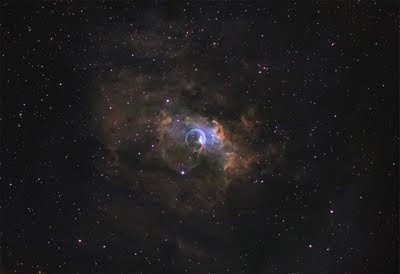
NGC 7635, also called the Bubble Nebula and Sharpless 162, is a H II region[2] emission nebula in the constellation Cassiopeia. It lies close to the direction of the open cluster Messier 52. The "bubble" is created by the stellar wind from a massive hot, 8.7[2] magnitude young central star, the 15 ± 5 M☉[4] SAO 20575 (BD+60 2522).[7] The nebula is near a giant molecular cloud which contains the expansion of the bubble nebula while itself being excited by the hot central star, causing it to glow.[7] It was discovered in 1787 by Friedrich Wilhelm Herschel.[6] The star SAO 20575 or BD+602522 is thought to have a mass of 10-40 Solar masses.
W.O FLT-110 with dedicated field flattener
EQ6 Pro
ST10XME
Astrodon 5nm Ha filter
Baader 8nm SII filter
Baader 8.5nm OIII filter
Ha: 3h 20min
SII: 4h 20min
OIII:4h
Total exposure 11h40min under near full moon from Kallithea Athens Greece.
Anacortes Image of the Day 08/09/2009

60% of the original size

NGC 7635, also called the Bubble Nebula and Sharpless 162, is a H II region[2] emission nebula in the constellation Cassiopeia. It lies close to the direction of the open cluster Messier 52. The "bubble" is created by the stellar wind from a massive hot, 8.7[2] magnitude young central star, the 15 ± 5 M☉[4] SAO 20575 (BD+60 2522).[7] The nebula is near a giant molecular cloud which contains the expansion of the bubble nebula while itself being excited by the hot central star, causing it to glow.[7] It was discovered in 1787 by Friedrich Wilhelm Herschel.[6] The star SAO 20575 or BD+602522 is thought to have a mass of 10-40 Solar masses.
W.O FLT-110 with dedicated field flattener
EQ6 Pro
ST10XME
Astrodon 5nm Ha filter
Baader 8nm SII filter
Baader 8.5nm OIII filter
Ha: 3h 20min
SII: 4h 20min
OIII:4h
Total exposure 11h40min under near full moon from Kallithea Athens Greece.
Anacortes Image of the Day 08/09/2009
Wednesday, August 26, 2009
M15 Globular Cluster
60% of the original size
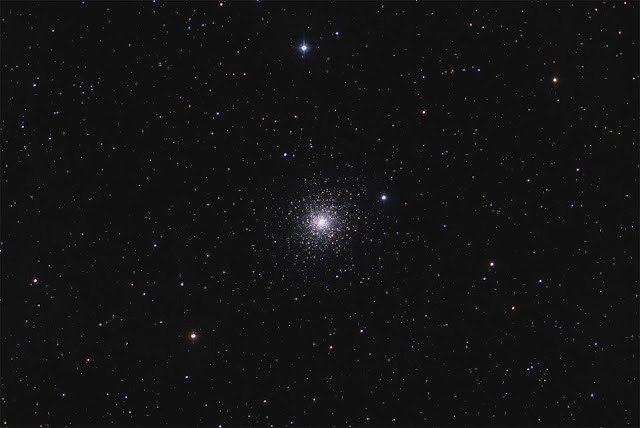
full resolution
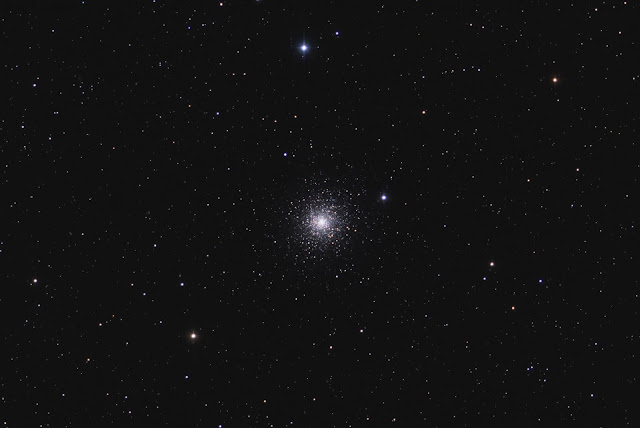
Messier 15 or M15 (also designated NGC 7078) is a globular cluster in the constellation Pegasus. It was discovered by Jean-Dominique Maraldi in 1746 and included in Charles Messier's catalogue of comet-like objects in 1764. At an estimated 13.2 billion years old, it is one of the oldest known globular clusters.
M15 is about 33,600 light-years from Earth. It has an absolute magnitude of -9.2 which translates to a total luminosity of 360,000 times that of the Sun. Messier 15 is one of the most densely packed globulars known in the Milky Way galaxy. Its core has undergone a contraction known as 'core collapse' and it has a central density cusp with an enormous number of stars surrounding what may be a central black hole.[citation needed]
Messier 15 contains 112 variable stars, a rather high number. It also contains at least 8 pulsars, including one double neutron star system, M15 C. Moreover, M15 houses Pease 1, one of only four planetary nebulae known to reside within a globular cluster, which was discovered in 1928.[1]
To the amateur astronomer Messier 15 appears as a fuzzy star in the smallest of telescopes. Mid to large size telescopes (at least 6 in./150 mm diameter) will start to reveal individual stars, the brightest of which are of magnitude +12.6.
To the upper left corner of the image it's also visible a very faint Spiral Galaxy IC5115
FLT110
EQ6 Pro
ST10XME
13*3min Blue
9*3min Green
11*3min Red
Total exposure 1h39min

full resolution

Messier 15 or M15 (also designated NGC 7078) is a globular cluster in the constellation Pegasus. It was discovered by Jean-Dominique Maraldi in 1746 and included in Charles Messier's catalogue of comet-like objects in 1764. At an estimated 13.2 billion years old, it is one of the oldest known globular clusters.
M15 is about 33,600 light-years from Earth. It has an absolute magnitude of -9.2 which translates to a total luminosity of 360,000 times that of the Sun. Messier 15 is one of the most densely packed globulars known in the Milky Way galaxy. Its core has undergone a contraction known as 'core collapse' and it has a central density cusp with an enormous number of stars surrounding what may be a central black hole.[citation needed]
Messier 15 contains 112 variable stars, a rather high number. It also contains at least 8 pulsars, including one double neutron star system, M15 C. Moreover, M15 houses Pease 1, one of only four planetary nebulae known to reside within a globular cluster, which was discovered in 1928.[1]
To the amateur astronomer Messier 15 appears as a fuzzy star in the smallest of telescopes. Mid to large size telescopes (at least 6 in./150 mm diameter) will start to reveal individual stars, the brightest of which are of magnitude +12.6.
To the upper left corner of the image it's also visible a very faint Spiral Galaxy IC5115
FLT110
EQ6 Pro
ST10XME
13*3min Blue
9*3min Green
11*3min Red
Total exposure 1h39min
Monday, August 10, 2009
NGC 281 in Mapped Color
57% of the original size
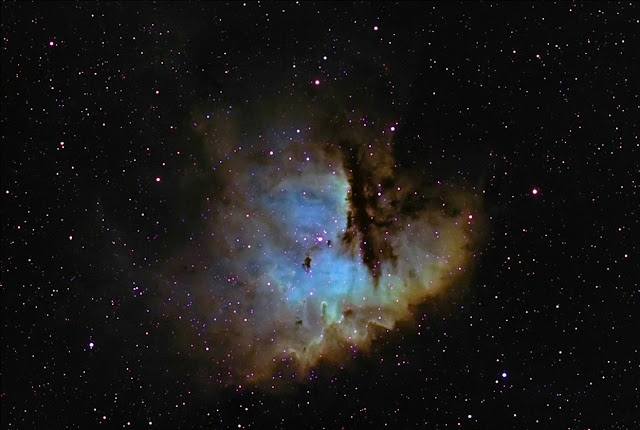
full resolution
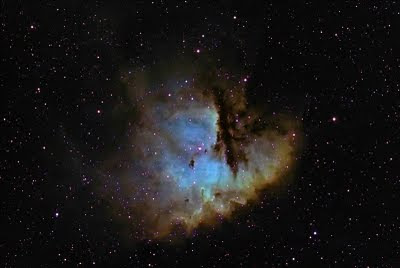
NGC 281 is an H II region in the constellation of Cassiopeia and part of the Perseus Spiral Arm. It includes or is near the open cluster IC 1590, the double star HD 5005, and several Bok globules. It is visible in amateur telescopes from dark sky locations. It is sometimes unofficially referred to as the Pacman Nebula owing to its fancied resemblance to the eponymous hero of the arcade game Pac-Man.
[SII], H-alpha, and [OIII] mapped to red, green, and blue, respectively. H-alpha data also used as luminance.
Ha_SIIHaOIII
Ha: 7x10min
SII: 8x10min
OIII: 7x10min
Total exposure only 3h40min under full moon from Kallithea Athens Greece.

full resolution

NGC 281 is an H II region in the constellation of Cassiopeia and part of the Perseus Spiral Arm. It includes or is near the open cluster IC 1590, the double star HD 5005, and several Bok globules. It is visible in amateur telescopes from dark sky locations. It is sometimes unofficially referred to as the Pacman Nebula owing to its fancied resemblance to the eponymous hero of the arcade game Pac-Man.
[SII], H-alpha, and [OIII] mapped to red, green, and blue, respectively. H-alpha data also used as luminance.
Ha_SIIHaOIII
Ha: 7x10min
SII: 8x10min
OIII: 7x10min
Total exposure only 3h40min under full moon from Kallithea Athens Greece.
Monday, July 27, 2009
M27, The Dumbbell Nebula final
Sunday, July 26, 2009
M27 , the Dumbbell Nebula
68% of full resolution

full resolution

This is the colour version of the Dumbbell Nebula with (Ha-Red):G:B technique.
See "Color Imaging of Nebulae using Hydrogen-Alpha Data" by: Robert Gendler

full resolution

This is the colour version of the Dumbbell Nebula with (Ha-Red):G:B technique.
See "Color Imaging of Nebulae using Hydrogen-Alpha Data" by: Robert Gendler
Monday, July 13, 2009
M27 , the Dumbbell Nebula in Hydrogen Alpha Light
invert
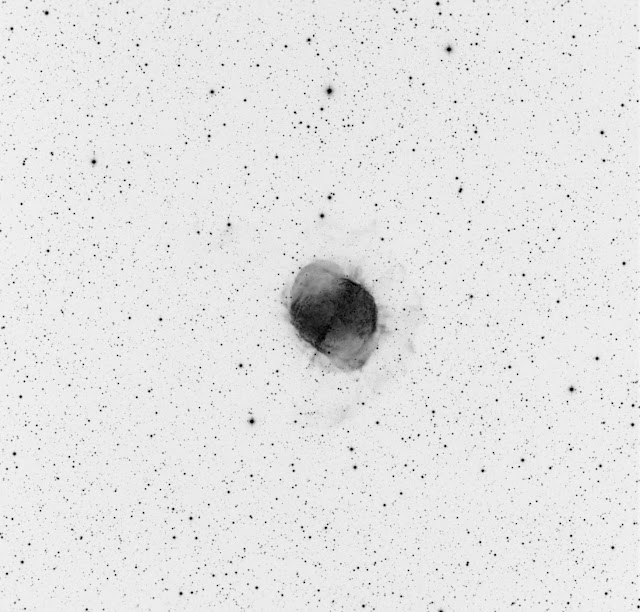
68% of full resolution

Full resolution
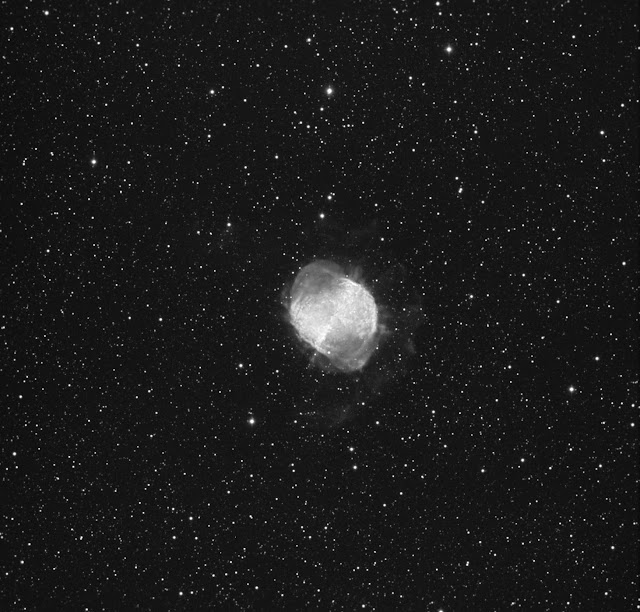
EQ6,FLT110,ST10XME Ha 5nm 8,5 hours exposure.
The Dumbbell Nebula (also known as Messier 27, M 27, or NGC 6853) is a planetary nebula (PN) in the constellation Vulpecula, at a distance of about 1,360 light years.
This object was the first planetary nebula to be discovered; by Charles Messier in 1764. At its brightness of visual magnitude 7.5 and its diameter of about 8 arcminutes, it is easily visible in binoculars, and a popular observing target in amateur telescopes.
Τελικά κατάφερα να μαζέψω τα φωτόνια που ήθελα....με τη βοήθεια του Φεγγαριού μάζεψα λίγα παραπάνω ,αλλά τι να κάνεις αυτά έχει η ζωή...!
EQ6 EQMOD FLT110 TMB FF ST10XME .
510 λεπτά (10x5min + 46x10min) στο 5nm Ηα της Astrodon ή 8,5 ώρες σε 4 νύχτες στη διάρκεια 2 εβδομάδων!!!
Όλη η επεξεργασία έγινε αποκλειστικά στο CCDStack με μια μικρή επέμβαση στα curves στο PS.
Αποθορυβοποίηση με 33% ΝoiseNinja
Καμία αισθητική ή άλλου είδους επέμβαση στα άστρα.
Την 1η νύχτα από λάθος η κάμερα ήταν τοποθετημένη 90 μοίρες clockwise...για αυτό και έχει γίνει crop στην κεντρική περιοχή .
Anacortes Image of the Day 07/26/2009

68% of full resolution

Full resolution

EQ6,FLT110,ST10XME Ha 5nm 8,5 hours exposure.
The Dumbbell Nebula (also known as Messier 27, M 27, or NGC 6853) is a planetary nebula (PN) in the constellation Vulpecula, at a distance of about 1,360 light years.
This object was the first planetary nebula to be discovered; by Charles Messier in 1764. At its brightness of visual magnitude 7.5 and its diameter of about 8 arcminutes, it is easily visible in binoculars, and a popular observing target in amateur telescopes.
Τελικά κατάφερα να μαζέψω τα φωτόνια που ήθελα....με τη βοήθεια του Φεγγαριού μάζεψα λίγα παραπάνω ,αλλά τι να κάνεις αυτά έχει η ζωή...!
EQ6 EQMOD FLT110 TMB FF ST10XME .
510 λεπτά (10x5min + 46x10min) στο 5nm Ηα της Astrodon ή 8,5 ώρες σε 4 νύχτες στη διάρκεια 2 εβδομάδων!!!
Όλη η επεξεργασία έγινε αποκλειστικά στο CCDStack με μια μικρή επέμβαση στα curves στο PS.
Αποθορυβοποίηση με 33% ΝoiseNinja
Καμία αισθητική ή άλλου είδους επέμβαση στα άστρα.
Την 1η νύχτα από λάθος η κάμερα ήταν τοποθετημένη 90 μοίρες clockwise...για αυτό και έχει γίνει crop στην κεντρική περιοχή .
Anacortes Image of the Day 07/26/2009
Sunday, July 5, 2009
Williams Optics FLT 110 CCD Inspector Results
Field Curvature Map

3-D Viewer - Edge view

3-D Viewer

These are the typical CCDInspector2 results with the SBIG ST10XME camera used on the FLT110 OTA with TMB dedicated field flattener.
These examples were taken from an imaging session of M27 through the Baader Planetarium luminance filter.
The results show a very flat field.The sensor size is 14.9 x 10 mm with 6.8x6.8 microns pixels.
The CCDInspector2 from CCDWare is a wonderful program!!!!

3-D Viewer - Edge view

3-D Viewer

These are the typical CCDInspector2 results with the SBIG ST10XME camera used on the FLT110 OTA with TMB dedicated field flattener.
These examples were taken from an imaging session of M27 through the Baader Planetarium luminance filter.
The results show a very flat field.The sensor size is 14.9 x 10 mm with 6.8x6.8 microns pixels.
The CCDInspector2 from CCDWare is a wonderful program!!!!
Sunday, June 21, 2009
My current astrophotography setup

Sky-Watcher EQ6 PRO
William Optics FLT110 triplet air-spaced APO lens TMB design
Dedicated TMB field flattener
SBIG ST10XME with CFW9
William Optics ZenithStar II 80mm Doublet ED
Meade DSI
Sunday, June 14, 2009
NGC 6823, NGC 6820 Open cluster and nebulosity in Vulpecula

NGC 6820 is an emission nebula that surrounds open cluster NGC 6823 in Vulpecula, near M27, the Dumbbell Nebula.
The most striking feature is the trunk-like pillar or dust and gas protruding from the east side of the nebula towards the open cluster, NGC 6823 in the west. The center of the open cluster is about two million years old and is predominantly represented by many young, bright blue stars. Outer parts of the cluster intimately involving pillars of emission nebula NGC 6820, contain even younger stars. The huge pillars of gas and dust are probably formed when surrounding gas and dust is pushed and eroded away by radiation from nearby stars. Remarkable dark globules of gas and dust are also visible in the nebula, much as is seen in the better known Eagle Nebula in Serpens or the Lagoon Nebula in Sagittarius.
Open star cluster NGC 6823 is about 50 light years across and lies about 6000 light years away.
Ha 33x5min
W.O FLT110
SBIG ST10XME_CFW9_Astrodon Ha 5nm
EQ6Pro
Wednesday, May 20, 2009
M106 rework

M106 is at a distance of about 22 to 25 million light-years away from Earth
Messier 106 (also known as NGC 4258) is a spiral galaxy about in the constellation Canes Venatici. It was discovered by Pierre Mechain in 1781.It is also a Seyfert II galaxy, which means that due to x-rays and unusual emission lines detected, it is suspected that part of the galaxy is falling into a supermassive black hole in the center.[7] NGC 4217 is a possible companion galaxy of Messier 106.[6]
M106-NGC4248
PGC39615 mag:15,8 PGC2291799 mag:18.2
PGC2832111 mag:30,0
and many more...
W.O FLT110
4''flattener W.O TMB
Sbig ST10XME – sfw9 with Baader LRGB set
W.O ZenithStar 80II ED
Meade DSI I color
EQ6Pro
Total Exposure 5h20min
L:140min R:50 G:55 B:70
CcdSoft, CcdStack, MaximDL, PS2
28-2-2009
Kallithea
Athens
Hellas
Subscribe to:
Posts (Atom)






60.jpg)






GBcopy3-68%25.jpg)
GB.jpg)

